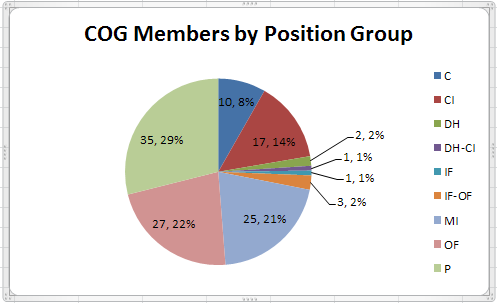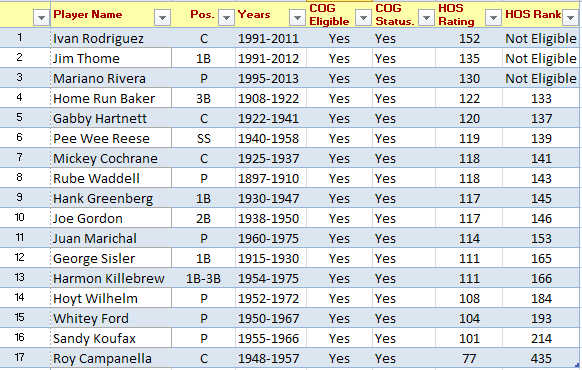Our project at High Heat Stats to elect our version of the Hall of Fame has completed (for now) after 121 rounds of balloting, and 121 players elected to the Circle of Greats (COG). This matches the number of Hall of Fame (HOF) members elected by the Baseball Writers Association of America (BBWAA). As the BBWAA elects additional members in future years, the intention is to resume COG balloting at those times to maintain a matching number of honorees.
This post provides analysis of HOF and COG selections, identifying where our voters agreed with the BBWAA and where we differed. I’ve also provided comparison to Adam Darowski‘s Hall of Stats to see the similarities and differences between Adam’s selections and the HOF and COG honorees.
More after the jump.
As our intention was to compare COG selections with those by the BBWAA, let’s start there. Here’s the result in a table that can be searched or sorted to your preference.
[table id=285 /]
.
Summarizing these results provides this view of the COG membership.
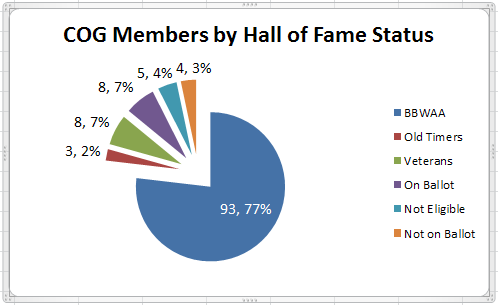
So, more than three-quarters of our COG selections were also selected to the Hall of Fame by the BBWAA. Of the remaining 28 players, 11 were selected to the Hall of Fame by other committees and 8 were on the 2016 BBWAA ballot. Remaining are five players not eligible for HOF selection (three will become eligible shortly) and four who are eligible but are still waiting for election.
Let’s look at those 28 players that we chose and the BBWAA did not.
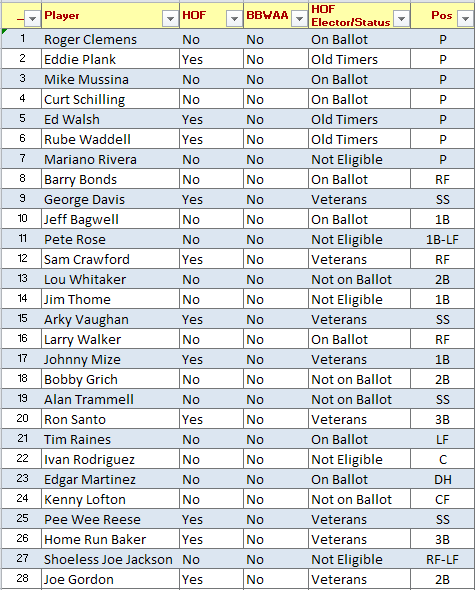
In effect, our selections above were made in preference to the players below that the BBWAA selected and we passed on, or have not yet selected. To be quite correct, the BBWAA did not “pass” on all of the players above. Those selected by the Old Timers Committee probably were deemed ineligible to be selected by the BBWAA (I say “probably” because I don’t know enough about the history of HOF voting to know exactly which players the BBWAA considered or did not consider).
Those caveats aside, I think we’ve done a pretty good job; for the most part, our selections look (to me) more defensible than the ones below made by the BBWAA that we passed on.
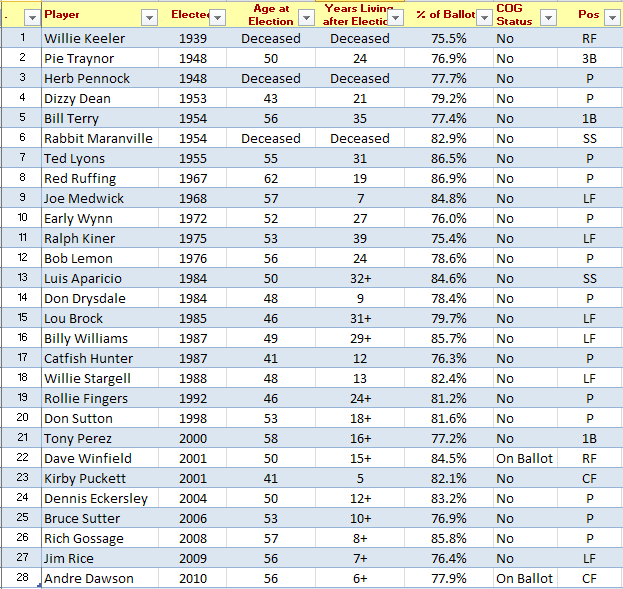
Let’s compare the COG and BBWAA selections by position. Here are the COG choices.
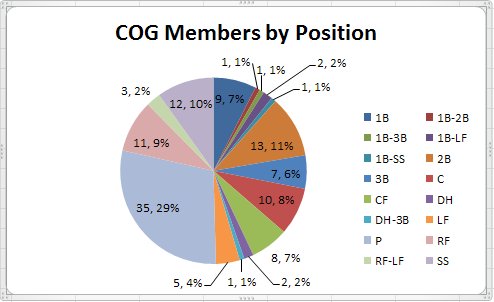
Our choices show a clear preference for “strength up the middle” with the top positions being (in order) pitcher, second base, shortstop and catcher (tied with first base). The chart is a bit too finely granulated to see clearly, so here’s a higher level summary.
So, after pitchers, almost an even split between outfielders and middle infielders. How does that compare to the BBWAA selections?
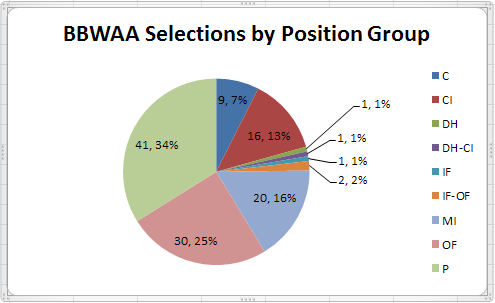 A bit different story.The BBWAA has more pitchers than the COG and, instead of being evenly split as in the COG, the BBWAA favors outfielders over middle infielders by a 3 to 2 ratio. Corner infielders and catchers are represented in about the same proportions as in the COG.
A bit different story.The BBWAA has more pitchers than the COG and, instead of being evenly split as in the COG, the BBWAA favors outfielders over middle infielders by a 3 to 2 ratio. Corner infielders and catchers are represented in about the same proportions as in the COG.
Here’s another way to look at the data above.
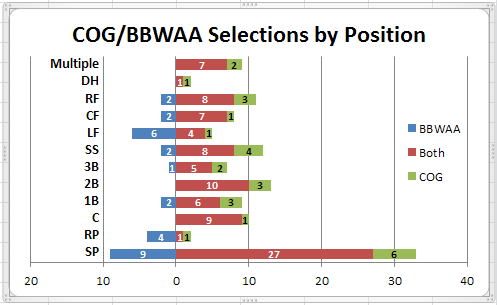 The brown bars represent common selections by the COG and the BBWAA, while blue were selected only by the BBWAA and green only by the COG. I’ve broken out pitchers into starters and relievers, as the BBWAA preference for recognizing top relievers is in marked contrast to the COG.
The brown bars represent common selections by the COG and the BBWAA, while blue were selected only by the BBWAA and green only by the COG. I’ve broken out pitchers into starters and relievers, as the BBWAA preference for recognizing top relievers is in marked contrast to the COG.
Hall of Stats
To close, here’s a look at how our COG selections compare to Adam Darowski’s Hall of Stats. If you haven’t seen Adam’s website, I strongly encourage you to do so; it’s an outstanding piece of work. What Adam has done is to remove subjectivity entirely from the selection process in choosing an alternate Hall of Fame based solely on statistical measures (all the details are explained on the site).
A Hall of Stats rating is calculated for every major league player with those scoring 100 or above and who have been retired for 5 seasons (as in HOF eligibility) being enshrined into the Hall of Stats (HOS). The rating scale is adjusted so that the number of players with a 100 or higher score (currently 217) matches the number of players elected (by all committees) to the Hall of Fame (one wrinkle is that players on the bubble with a HOS rating close to 100 could drop below 100, and out of the HOS, as the HOS rating is recalibrated when additional players become eligible for HOS enshrinement).
Here are our COG members again, showing their HOS rating and rank.
[table id=286 /]
.
As the HOS includes all players in its ratings and rankings, to compare to the COG selections, I’ve made the cutoff at ranking position 131, as there are ten 19th century players not eligible for the COG who are ranked in the top 131 in the HOS (and, thus, 121 COG-eligible players in those top 131). Here are the players the HOS likes in preference to our COG selections.
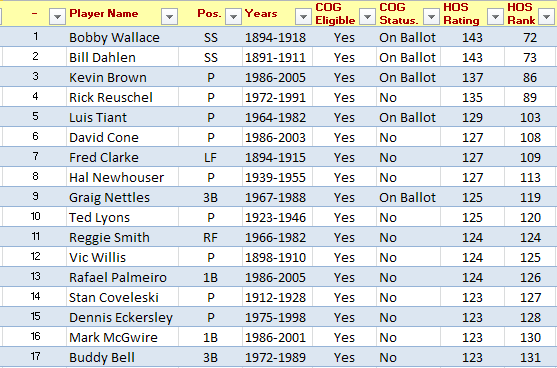
Fewer differences between the COG and HOS, than was the case between the COG and BBWAA selections. And, most of the differences, as would be expected, are in the borderline cases close to the bubble with several of the higher ranked exceptions still on the COG ballot (Resuchel was just dropped from the ballot in the last round of COG balloting).
The players below ranked outside the top 131 in the HOS (or are not yet eligible for the HOS) and were selected to the COG in preference to the higher ranked players above.
The three COG selections currently not eligible for the HOS will make it with ease. The three catchers in this list ranked outside the top 131 are indicative of a subjective allowance given by COG voters owing to the demands of the position often limiting career length. There is also an allowance given in the HOS ratings (thus, only Campanella is below a 100 HOS rating), otherwise Hartnett and Cochrane would be even further down the list and possibly also below a 100 rating.

